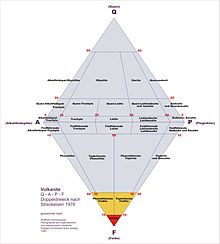Foidite
Foidites are rocks of volcanic origin, which consist of minerals of the foid group (at least 90% of the light components) and variable contents of feldspars and dark minerals. If the foid content is lower and the feldspar content is higher, the foidites decrease . st. to the phonolithic foidites ( alkali feldspar-dominated ) or tephritic foidites ( plagioclase-dominated ). Foidites belong to the group of alkaline rocks .
designation
Foidites are further subdivided on the basis of the existing foid minerals. If only one foid occurs in significant quantities, the rock is called nephelinite ( nepheline only ), leucitite ( leucite only ), etc. If several different foids are available, they are listed as an addition to the name (e.g. leucite-nosean-foidite). Other mineral names can also be placed in front if necessary (e.g. olivine nephelinite).
Mineralogical and chemical composition
The most common foid minerals in foidites are leucite and nepheline, but other foids such as analcime , nosean , Haüyn or sodalite can also occur in larger quantities. In addition to the foids, there are high-temperature alkali feldspar ( sanidine ) and plagioclase in variable proportions, but always in small quantities (maximum 10 percent by volume of the light-colored parts). At mafic are minerals often in larger quantities pyroxene , olivine , Melilith , Melanit , biotite , hornblende or wollastonite to find. Secondary components can be apatite and various titanium minerals such as B. perovskite or titanite . The Foidites are in field 15 in the classification diagram according to Fahrtisen .
The chemical composition of the foidites reflects their modal mineral composition . It is characterized by a high content of alkali metals ( sodium for nephelinite, potassium for leucitite) along with a low content of SiO 2 .
Occurrence
Foidites occur in the form of pyroclastics and lavas in volcanic areas worldwide. Well-known deposits for leucitite are, for example, Vesuvius and the Roman volcanic province in Italy . In Europe, nephelinite occurs in the Vulkaneifel , on the Vogelsberg , on the Katzenbuckel , in the Kaiserstuhl (all in Germany ) and in the volcanic Central Massif in France .
literature
- Walter Maresch, Olaf Medenbach: Rocks . With the collaboration of Hans Dieter Trochim. Edited by Gunter Steinbach . New, edited special edition. Mosaik-Verlag, Munich 1987, ISBN 3-576-10699-5 ( Steinbach's natural guide ).
